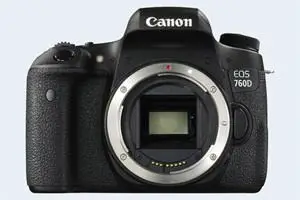Panasonic TZ100 vs Canon 760D
The Panasonic Lumix DMC-TZ100 (called Panasonic ZS100 in some regions) and the Canon EOS 760D (labelled Canon T6s in some countries) are two digital cameras that were announced, respectively, in January 2016 and February 2015. The TZ100 is a fixed lens compact, while the 760D is a DSLR. The cameras are based on an one-inch (TZ100) and an APS-C (760D) sensor. The Panasonic has a resolution of 20 megapixels, whereas the Canon provides 24 MP.
Below is an overview of the main specs of the two cameras as a starting point for the comparison.

Check TZ100 offers at
ebay.com

Check 760D offers at
ebay.com
Going beyond this snapshot of core features and characteristics, what are the differences between the Panasonic Lumix DMC-TZ100 and the Canon EOS 760D? Which one should you buy? Read on to find out how these two cameras compare with respect to their body size, their imaging sensors, their shooting features, their input-output connections, and their reception by expert reviewers.
Body comparison
An illustration of the physical size and weight of the Panasonic TZ100 and the Canon 760D is provided in the side-by-side display below. The two cameras are presented according to their relative size. Three successive views from the front, the top, and the rear are shown. All size dimensions are rounded to the nearest millimeter.
The TZ100 can be obtained in two different colors (black, silver), while the 760D is only available in black.
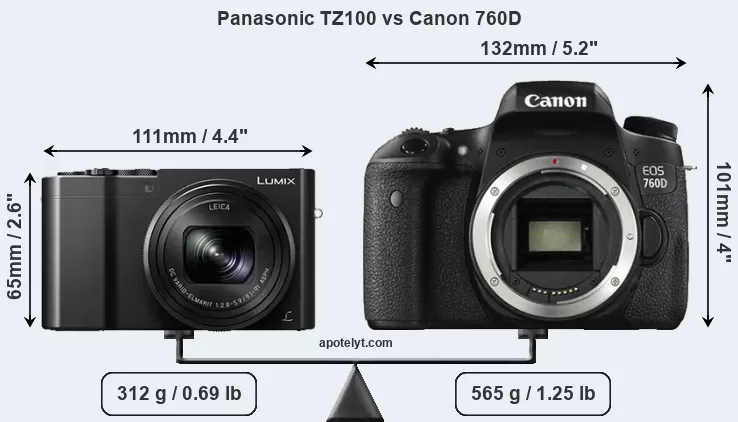
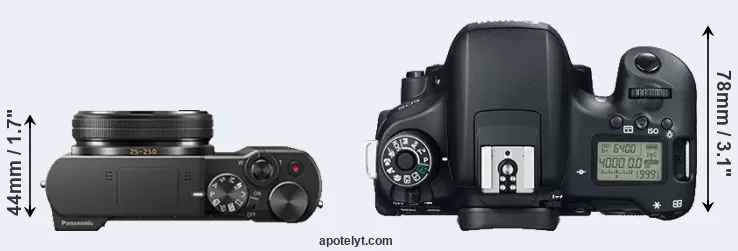
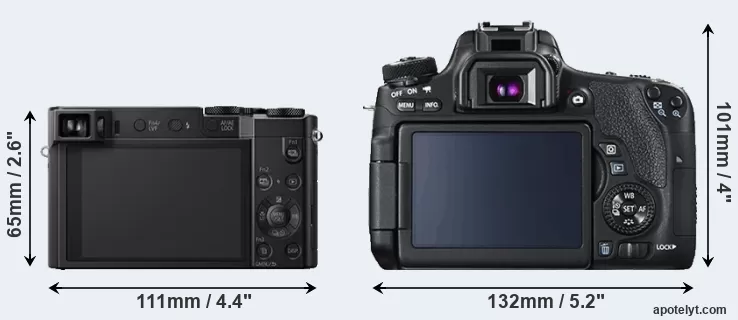
If the front view area (width x height) of the cameras is taken as an aggregate measure of their size, the Canon 760D is considerably larger (85 percent) than the Panasonic TZ100. In this context, it is worth noting that neither the TZ100 nor the 760D are weather-sealed.
The above size and weight comparisons are to some extent incomplete and possibly misleading, as the TZ100 has a lens built in, whereas the 760D is an interchangeable lens camera that requires a separate lens. Attaching the latter will add extra weight and bulk to the setup. You can compare the optics available for the 760D and their specifications in the Canon EF Lens Catalog.
Concerning battery life, the TZ100 gets 300 shots out of its Panasonic DMW-BLG10 battery, while the 760D can take 440 images on a single charge of its Canon LP-E17 power pack. The power pack in the TZ100 can be charged via the USB port, so that it is not always necessary to take the battery charger along when travelling.
The adjacent table lists the principal physical characteristics of the two cameras alongside a wider set of alternatives. If you want to switch the focus of the display and review another camera pair, you can move across to the CAM-parator tool and choose from the broad selection of possible camera comparisons there.

| Camera Model |
Camera Width |
Camera Height |
Camera Depth |
Camera Weight |
Battery Life |
Weather Sealing |
Camera Launch |
Launch Price (USD) |
Street Price |
||
|---|---|---|---|---|---|---|---|---|---|---|---|
| 1. | Panasonic TZ100 | 111 mm | 65 mm | 44 mm | 312 g | 300 | n | Jan 2016 | 699 | ebay.com | |
| 2. | Canon 760D | 132 mm | 101 mm | 78 mm | 565 g | 440 | n | Feb 2015 | 649 | ebay.com | |
| 3. | Canon 77D | 131 mm | 100 mm | 76 mm | 540 g | 600 | n | Feb 2017 | 899 | ebay.com | |
| 4. | Canon 750D | 132 mm | 101 mm | 78 mm | 555 g | 440 | n | Feb 2015 | 749 | ebay.com | |
| 5. | Canon G1 X Mark II | 116 mm | 74 mm | 66 mm | 553 g | 240 | n | Feb 2014 | 799 | ebay.com | |
| 6. | Canon G5 X | 112 mm | 76 mm | 44 mm | 353 g | 210 | n | Oct 2015 | 799 | ebay.com | |
| 7. | Canon G7 X | 103 mm | 60 mm | 40 mm | 304 g | 210 | n | Sep 2014 | 699 | ebay.com | |
| 8. | Canon G7 X Mark II | 106 mm | 61 mm | 42 mm | 319 g | 265 | n | Feb 2016 | 699 | ebay.com | |
| 9. | Canon M3 | 111 mm | 68 mm | 44 mm | 366 g | 250 | n | Feb 2015 | 679 | ebay.com | |
| 10. | Canon M5 | 116 mm | 89 mm | 61 mm | 427 g | 295 | n | Sep 2016 | 979 | ebay.com | |
| 11. | Panasonic GX80 | 122 mm | 71 mm | 44 mm | 426 g | 290 | n | Apr 2016 | 799 | amazon.com | |
| 12. | Panasonic LX15 | 106 mm | 60 mm | 42 mm | 310 g | 260 | n | Sep 2016 | 699 | amazon.com | |
| 13. | Panasonic TZ90 | 112 mm | 67 mm | 41 mm | 322 g | 380 | n | Apr 2017 | 449 | ebay.com | |
| 14. | Panasonic TZ200 | 111 mm | 65 mm | 45 mm | 340 g | 370 | n | Feb 2018 | 799 | amazon.com | |
| 15. | Sony RX100 IV | 102 mm | 58 mm | 41 mm | 298 g | 280 | n | Jun 2015 | 999 | ebay.com | |
| 16. | Sony RX100 V | 102 mm | 58 mm | 41 mm | 299 g | 220 | n | Oct 2016 | 999 | ebay.com | |
| Note: Measurements and pricing do not include easily detachable parts, such as add-on or interchangeable lenses or optional viewfinders. | |||||||||||
The price is, of course, an important factor in any camera decision. The listed launch prices provide an indication of the market segment that the manufacturer of the cameras have been targeting. Normally, street prices remain initially close to the MSRP, but after a couple of months, the first discounts appear. Later in the product cycle and, in particular, when the replacement model is about to appear, further discounting and stock clearance sales often push the camera price considerably down.
Sensor comparison
The size of the imaging sensor is a crucial determinant of image quality. A large sensor will generally have larger individual pixels that offer better low-light sensitivity, provide wider dynamic range, and have richer color-depth than smaller pixels in a sensor of the same technological generation. Moreover, a large sensor camera will give the photographer more control over depth-of-field in the image and, thus, the ability to better isolate a subject from the background. On the downside, larger sensors tend to be more expensive and lead to bigger and heavier cameras and lenses.
Of the two cameras under consideration, the Panasonic TZ100 features an one-inch sensor and the Canon 760D an APS-C sensor. The sensor area in the 760D is 186 percent bigger. As a result of these sensor size differences, the cameras have a format factor of, respectively, 2.7 and 1.6. Both cameras have a native aspect ratio (sensor width to sensor height) of 3:2.
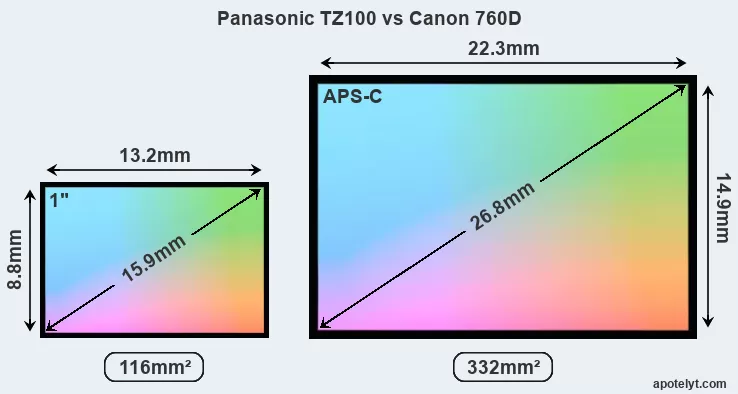
With 24MP, the 760D offers a higher resolution than the TZ100 (20MP), but the 760D nevertheless has larger individual pixels (pixel pitch of 3.72μm versus 2.41μm for the TZ100) due to its larger sensor. However, the TZ100 is a somewhat more recent model (by 10 months) than the 760D, and its sensor might have benefitted from technological advances during this time that enhance the light gathering capacity of its pixel-units.
The resolution advantage of the Canon 760D implies greater flexibility for cropping images or the possibility to print larger pictures. The maximum print size of the 760D for good quality output (200 dots per inch) amounts to 30 x 20 inches or 76.2 x 50.8 cm, for very good quality (250 dpi) 24 x 16 inches or 61 x 40.6 cm, and for excellent quality (300 dpi) 20 x 13.3 inches or 50.8 x 33.9 cm. The corresponding values for the Panasonic TZ100 are 27.4 x 18.2 inches or 69.5 x 46.3 cm for good quality, 21.9 x 14.6 inches or 55.6 x 37.1 cm for very good quality, and 18.2 x 12.2 inches or 46.3 x 30.9 cm for excellent quality prints.
The 760D has on-sensor phase detect pixels, which results in fast and reliable autofocus acquisition even during live view operation.
The Panasonic Lumix DMC-TZ100 has a native sensitivity range from ISO 125 to ISO 12800, which can be extended to ISO 80-25600. The corresponding ISO settings for the Canon EOS 760D are ISO 100 to ISO 12800, with the possibility to increase the ISO range to 100-25600.
Technology-wise, both cameras are equipped with CMOS (Complementary Metal–Oxide–Semiconductor) sensors. Both cameras use a Bayer filter for capturing RGB colors on a square grid of photosensors. This arrangement is found in most digital cameras.
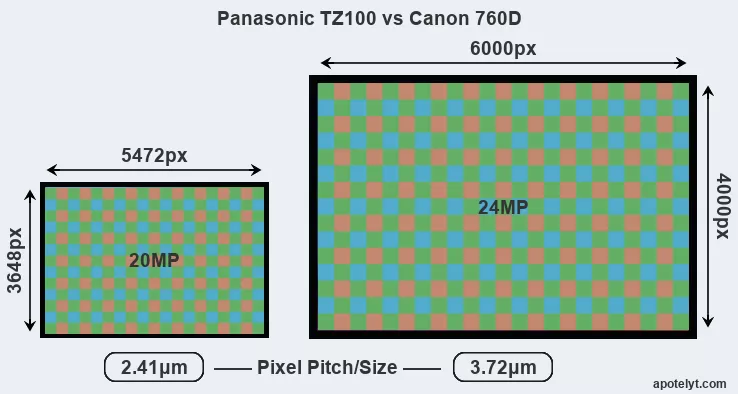
For many cameras, data on sensor performance has been reported by DXO Mark. This service is based on lab testing and assigns an overall score to each camera sensor, as well as ratings for dynamic range ("DXO Landscape"), color depth ("DXO Portrait"), and low-light sensitivity ("DXO Sports"). The Overall DXO ratings for the two cameras under consideration are close, suggesting that they provide similar imaging performance. The table below summarizes the physical sensor characteristics and sensor quality findings and compares them across a set of similar cameras.

| Camera Model |
Sensor Class |
Resolution (MP) |
Horiz. Pixels |
Vert. Pixels |
Video Format |
DXO Portrait |
DXO Landscape |
DXO Sports |
DXO Overall |
||
|---|---|---|---|---|---|---|---|---|---|---|---|
| 1. | Panasonic TZ100 | 1-inch | 20.0 | 5472 | 3648 | 4K/30p | 22.8 | 12.5 | 559 | 70 | |
| 2. | Canon 760D | APS-C | 24.0 | 6000 | 4000 | 1080/30p | 22.6 | 12.0 | 915 | 70 | |
| 3. | Canon 77D | APS-C | 24.0 | 6000 | 4000 | 1080/60p | 23.6 | 13.3 | 971 | 78 | |
| 4. | Canon 750D | APS-C | 24.0 | 6000 | 4000 | 1080/30p | 22.7 | 12.0 | 919 | 71 | |
| 5. | Canon G1 X Mark II | 1.5-inch | 13.0 | 4160 | 3120 | 1080/30p | 21.5 | 10.8 | 581 | 58 | |
| 6. | Canon G5 X | 1-inch | 20.0 | 5472 | 3648 | 1080/60p | 21.4 | 12.3 | 471 | 62 | |
| 7. | Canon G7 X | 1-inch | 20.0 | 5472 | 3648 | 1080/60p | 23.0 | 12.7 | 556 | 71 | |
| 8. | Canon G7 X Mark II | 1-inch | 20.0 | 5472 | 3648 | 1080/60p | 21.8 | 11.9 | 260 | 62 | |
| 9. | Canon M3 | APS-C | 24.0 | 6000 | 4000 | 1080/30p | 22.8 | 11.8 | 1169 | 72 | |
| 10. | Canon M5 | APS-C | 24.0 | 6000 | 4000 | 1080/60p | 23.4 | 12.4 | 1262 | 77 | |
| 11. | Panasonic GX80 | Four Thirds | 15.8 | 4592 | 3448 | 4K/30p | 22.9 | 12.6 | 662 | 71 | |
| 12. | Panasonic LX15 | 1-inch | 20.0 | 5472 | 3648 | 4K/30p | 21.9 | 12.0 | 315 | 62 | |
| 13. | Panasonic TZ90 | 1/2.3 | 20.2 | 5184 | 3888 | 4K/30p | 19.1 | 10.6 | 106 | 36 | |
| 14. | Panasonic TZ200 | 1-inch | 20.0 | 5472 | 3648 | 4K/30p | 22.0 | 12.2 | 449 | 64 | |
| 15. | Sony RX100 IV | 1-inch | 20.0 | 5472 | 3648 | 4K/30p | 22.8 | 12.6 | 591 | 70 | |
| 16. | Sony RX100 V | 1-inch | 20.0 | 5472 | 3648 | 4K/30p | 22.8 | 12.4 | 586 | 70 | |
| Note: DXO values in italics represent estimates based on sensor size and age. | |||||||||||
Many modern cameras cannot only take still pictures, but also record videos. Both cameras under consideration are equipped with sensors that have a sufficiently high read-out speed for moving images, but the TZ100 provides a higher video resolution than the 760D. It can shoot video footage at 4K/30p, while the Canon is limited to 1080/30p.
Feature comparison
Beyond body and sensor, cameras can and do differ across a range of features. For example, the TZ100 has an electronic viewfinder (1166k dots), while the 760D has an optical one. Both systems have their advantages, with the electronic viewfinder making it possible to project supplementary shooting information into the framing view, whereas the optical viewfinder offers lag-free viewing and a very clear framing image. The viewfinder in the TZ100 offers a wider field of view (100%) than the one in the 760D (95%), so that a larger proportion of the captured image is visible in the finder. On the other hand, the viewfinder of the 760D has a higher magnification (0.51x vs 0.46x), so that the size of the image transmitted appears closer to the size seen with the naked human eye. The adjacent table lists some of the other core features of the Panasonic TZ100 and Canon 760D along with similar information for a selection of comparators.

| Camera Model |
Viewfinder (Type or 000 dots) |
Control Panel (yes/no) |
LCD Specifications (inch/000 dots) |
LCD Attach- ment |
Touch Screen (yes/no) |
Max Shutter Speed * |
Max Shutter Flaps * |
Built-in Flash (yes/no) |
Built-in Image Stab |
||
|---|---|---|---|---|---|---|---|---|---|---|---|
| 1. | Panasonic TZ100 | 1166 | n | 3.0 / 1040 | fixed | Y | 1/2000s | 10.0/s | Y | Y | |
| 2. | Canon 760D | optical | Y | 3.0 / 1040 | swivel | Y | 1/4000s | 5.0/s | Y | n | |
| 3. | Canon 77D | optical | Y | 3.0 / 1040 | swivel | Y | 1/4000s | 6.0/s | Y | n | |
| 4. | Canon 750D | optical | n | 3.0 / 1040 | swivel | Y | 1/4000s | 5.0/s | Y | n | |
| 5. | Canon G1 X Mark II | optional | n | 3.0 / 1040 | tilting | Y | 1/4000s | 5.2/s | Y | Y | |
| 6. | Canon G5 X | 2360 | n | 3.0 / 1040 | swivel | Y | 1/2000s | 5.9/s | Y | Y | |
| 7. | Canon G7 X | none | n | 3.0 / 1040 | tilting | Y | 1/2000s | 6.5/s | Y | Y | |
| 8. | Canon G7 X Mark II | none | n | 3.0 / 1040 | tilting | Y | 1/2000s | 8.0/s | Y | Y | |
| 9. | Canon M3 | optional | n | 3.0 / 1040 | tilting | Y | 1/4000s | 4.2/s | Y | n | |
| 10. | Canon M5 | 2360 | n | 3.2 / 1620 | tilting | Y | 1/4000s | 9.0/s | Y | n | |
| 11. | Panasonic GX80 | 2765 | n | 3.0 / 1040 | tilting | Y | 1/4000s | 8.0/s | Y | Y | |
| 12. | Panasonic LX15 | none | n | 3.0 / 1040 | tilting | Y | 1/4000s | 10.0/s | Y | Y | |
| 13. | Panasonic TZ90 | 1166 | n | 3.0 / 1040 | tilting | Y | 1/2000s | 10.0/s | Y | Y | |
| 14. | Panasonic TZ200 | 2330 | n | 3.0 / 1240 | fixed | Y | 1/2000s | 10.0/s | Y | Y | |
| 15. | Sony RX100 IV | 2359 | n | 3.0 / 1228 | tilting | n | 1/2000s | 16.0/s | Y | Y | |
| 16. | Sony RX100 V | 2359 | n | 3.0 / 1229 | tilting | n | 1/2000s | 24.0/s | Y | Y | |
| Note: *) Information refers to the mechanical shutter, unless the camera only has an electronic one. | |||||||||||
One feature that is present on the 760D, but is missing on the TZ100 is a top-level LCD. While being, of course, smaller than the rear screen, the control panel conveys some of the essential shooting information and can be convenient for quick and easy settings verification.
The 760D has an articulated screen that can be turned to be front-facing. This characteristic will be appreciated by vloggers and photographers who are interested in taking selfies. In contrast, the TZ100 does not have a selfie-screen.The reported shutter speed information refers to the use of the mechanical shutter. Yet, some cameras only have an electronic shutter, while others have an electronic shutter in addition to a mechanical one. In fact, the TZ100 is one of those camera that have an additional electronic shutter, which makes completely silent shooting possible. However, this mode is less suitable for photographing moving objects (risk of rolling shutter) or shooting under artificial light sources (risk of flickering).
The Panasonic TZ100 has an intervalometer built-in. This enables the photographer to capture time lapse sequences, such as flower blooming, a sunset or moon rise, without purchasing an external camera trigger and related software.
Concerning the storage of imaging data, both the TZ100 and the 760D write their files to SDXC cards. Both cameras can use UHS-I cards, which provide for Ultra High Speed data transfer of up to 104 MB/s.
Connectivity comparison
For some imaging applications, the extent to which a camera can communicate with its environment can be an important aspect in the camera decision process. The table below provides an overview of the connectivity of the Panasonic Lumix DMC-TZ100 and Canon EOS 760D and, in particular, the interfaces the cameras (and selected comparators) provide for accessory control and data transfer.

| Camera Model |
Hotshoe Port |
Internal Mic / Speaker |
Microphone Port |
Headphone Port |
HDMI Port |
USB Port |
WiFi Support |
NFC Support |
Bluetooth Support |
||
|---|---|---|---|---|---|---|---|---|---|---|---|
| 1. | Panasonic TZ100 | - | stereo / mono | - | - | micro | 2.0 | Y | - | - | |
| 2. | Canon 760D | Y | stereo / mono | Y | - | mini | 2.0 | Y | Y | - | |
| 3. | Canon 77D | Y | stereo / mono | Y | - | mini | 2.0 | Y | Y | Y | |
| 4. | Canon 750D | Y | stereo / mono | Y | - | mini | 2.0 | Y | Y | - | |
| 5. | Canon G1 X Mark II | Y | stereo / mono | - | - | mini | 2.0 | Y | Y | - | |
| 6. | Canon G5 X | Y | stereo / mono | - | - | mini | 2.0 | Y | Y | - | |
| 7. | Canon G7 X | - | stereo / mono | - | - | micro | 2.0 | Y | Y | - | |
| 8. | Canon G7 X Mark II | - | stereo / mono | - | - | micro | 2.0 | Y | Y | - | |
| 9. | Canon M3 | Y | stereo / mono | Y | - | mini | 2.0 | Y | Y | - | |
| 10. | Canon M5 | Y | stereo / mono | Y | - | mini | 2.0 | Y | Y | Y | |
| 11. | Panasonic GX80 | Y | stereo / mono | - | - | micro | 2.0 | Y | - | - | |
| 12. | Panasonic LX15 | - | stereo / mono | - | - | micro | 2.0 | Y | - | - | |
| 13. | Panasonic TZ90 | - | stereo / mono | - | - | micro | 2.0 | Y | - | - | |
| 14. | Panasonic TZ200 | - | stereo / mono | - | - | micro | 2.0 | Y | - | Y | |
| 15. | Sony RX100 IV | - | stereo / mono | - | - | micro | 2.0 | Y | Y | - | |
| 16. | Sony RX100 V | - | stereo / mono | - | - | micro | 2.0 | Y | Y | - |
It is notable that the 760D has a microphone port, which can help to improve the quality of audio recordings by attaching an external microphone. The TZ100 does not feature such a mic input.
Both the TZ100 and the 760D have been discontinued, but can regularly be found used on ebay. The 760D was replaced by the Canon 77D, while the TZ100 was followed by the Panasonic TZ200. Further information on the features and operation of the TZ100 and 760D can be found, respectively, in the Panasonic TZ100 Manual (free pdf) or the online Canon 760D Manual.
Review summary
So how do things add up? Is there a clear favorite between the Panasonic TZ100 and the Canon 760D? Which camera is better? Below is a summary of the relative strengths of each of the two contestants.

Advantages of the Panasonic Lumix DMC-TZ100:
- Better video: Provides higher definition movie capture (4K/30p vs 1080/30p).
- More framing info: Has an electronic viewfinder that displays shooting data.
- More complete view: Has a viewfinder with a larger field of view (100% vs 95%).
- Faster burst: Shoots at higher frequency (10 vs 5 flaps/sec) to capture the decisive moment.
- Less disturbing: Has an electronic shutter option for completely silent shooting.
- Easier time-lapse photography: Has an intervalometer built-in for low frequency shooting.
- Ready to shoot: Comes with a built-in lens, while the 760D requires a separate lens.
- More compact: Is smaller (111x65mm vs 132x101mm) and thus needs less room in the bag.
- Less heavy: Is lighter even though it comes with a built-in lens (unlike the 760D).
- Easier travel charging: Can be conveniently charged via its USB port.
- Sharper images: Has hand-shake reducing image stabilization built-in.
- More modern: Is somewhat more recent (announced 10 months after the 760D).

Arguments in favor of the Canon EOS 760D:
- More detail: Has more megapixels (24 vs 20MP), which boosts linear resolution by 10%.
- Better low-light sensitivity: Can shoot in dim conditions (0.7 stops ISO advantage).
- Better live-view autofocus: Features on-sensor phase-detection for more confident autofocus.
- Better sound: Can connect to an external microphone for higher quality sound recording.
- Brighter framing: Features an optical viewfinder for clear, lag-free composition.
- Larger viewfinder image: Features a viewfinder with a higher magnification (0.51x vs 0.46x).
- Easier setting verification: Features a control panel on top to check shooting parameters.
- More flexible LCD: Has a swivel screen for odd-angle shots in portrait or landscape orientation.
- More selfie-friendly: Has an articulated screen that can be turned to be front-facing.
- Faster shutter: Has higher mechanical shutter speed (1/4000s vs 1/2000s) to freeze action.
- More flexible: Makes it possible to change lenses and thus to use specialty optics.
- Longer lasting: Gets more shots (440 versus 300) out of a single battery charge.
- Better lighting: Features a hotshoe and can thus hold and trigger an external flash gun.
- Easier device pairing: Supports NFC for fast wireless image transfer over short distances.
- More heavily discounted: Has been on the market for longer (launched in February 2015).
If the number of relative strengths (bullet points above) is taken as a guide, the 760D emerges as the winner of the match-up (15 : 12 points). However, the relevance of individual strengths will vary across photographers, so that you might want to apply your own weighing scheme to the summary points when reflecting and deciding on a new camera. A professional wildlife photographer will view the differences between cameras in a way that diverges from the perspective of a family photog, and a person interested in architecture has distinct needs from a sports shooter. Hence, the decision which camera is best and worth buying is often a very personal one.
How about other alternatives? Do the specifications of the Panasonic TZ100 and the Canon 760D place the cameras among the top in their class? Find out in the latest Best Superzoom Camera and Best DSLR Camera listings whether the two cameras rank among the cream of the crop.
In any case, while the specs-based evaluation of cameras can be instructive in revealing their potential as photographic tools, it says little about, for example, the shooting experience and imaging performance of the TZ100 and the 760D in practical situations. User reviews, such as those found at amazon, can sometimes inform about these issues, but such feedback is often incomplete, inconsistent, and biased.
Expert reviews
This is why hands-on reviews by experts are important. The following table reports the overall ratings of the cameras as published by some of the major camera review sites (amateurphotographer [AP], cameralabs [CL], digitalcameraworld [DCW], dpreview [DPR], ephotozine [EPZ], photographyblog [PB]). As can be seen, the professional reviewers agree in many cases on the quality of different cameras, but sometimes their assessments diverge, reinforcing the earlier point that a camera decision is often a very personal choice.

| Camera Model |
AP score |
CL score |
DCW score |
DPR score |
EPZ score |
PB score |
Camera Launch |
Launch Price (USD) |
Street Price |
||
|---|---|---|---|---|---|---|---|---|---|---|---|
| 1. | Panasonic TZ100 | 4.5/5 | + + | .. | 82/100 | 4.5/5 | 4.5/5 | Jan 2016 | 699 | ebay.com | |
| 2. | Canon 760D | 5/5 | + | .. | 77/100 | 4.5/5 | 4.5/5 | Feb 2015 | 649 | ebay.com | |
| 3. | Canon 77D | 4.5/5 | .. | 4/5 | 82/100 | 4.5/5 | 4/5 | Feb 2017 | 899 | ebay.com | |
| 4. | Canon 750D | 5/5 | .. | .. | 75/100 | 4.5/5 | 4.5/5 | Feb 2015 | 749 | ebay.com | |
| 5. | Canon G1 X Mark II | 3/5 | + | .. | 77/100 | 4/5 | 4.5/5 | Feb 2014 | 799 | ebay.com | |
| 6. | Canon G5 X | 5/5 | + + | .. | 78/100 | 4.5/5 | 4.5/5 | Oct 2015 | 799 | ebay.com | |
| 7. | Canon G7 X | 4/5 | + + | .. | 77/100 | 4.5/5 | 4.5/5 | Sep 2014 | 699 | ebay.com | |
| 8. | Canon G7 X Mark II | 4.5/5 | + + | .. | 81/100 | 4.5/5 | 4.5/5 | Feb 2016 | 699 | ebay.com | |
| 9. | Canon M3 | 4/5 | o | .. | 75/100 | 4.5/5 | 4/5 | Feb 2015 | 679 | ebay.com | |
| 10. | Canon M5 | 4/5 | + | 4/5 | 82/100 | 4/5 | 4/5 | Sep 2016 | 979 | ebay.com | |
| 11. | Panasonic GX80 | 4.5/5 | + + | .. | 82/100 | 5/5 | 5/5 | Apr 2016 | 799 | amazon.com | |
| 12. | Panasonic LX15 | .. | + + | 4/5 | 81/100 | 4/5 | 4.5/5 | Sep 2016 | 699 | amazon.com | |
| 13. | Panasonic TZ90 | .. | + + | 4/5 | .. | 4/5 | 4/5 | Apr 2017 | 449 | ebay.com | |
| 14. | Panasonic TZ200 | .. | + + | 4.5/5 | 81/100 | 4.5/5 | 4.5/5 | Feb 2018 | 799 | amazon.com | |
| 15. | Sony RX100 IV | 4.5/5 | + + | .. | 85/100 | 4/5 | 4.5/5 | Jun 2015 | 999 | ebay.com | |
| 16. | Sony RX100 V | 4.5/5 | + + | .. | 83/100 | 4/5 | 4.5/5 | Oct 2016 | 999 | ebay.com | |
| Note: (+ +) highly recommended; (+) recommended; (o) reviewed; (..) not available. | |||||||||||
The review scores listed above should be treated with care, though. The ratings are only valid when referring to cameras in the same category and of the same age. Thus, a score needs to be put into the context of the launch date and the launch price of the camera, and rating-comparisons among cameras that span long time periods or concern very differently equipped models make little sense. Also, kindly note that some of the listed sites have over time developped their review approaches and their reporting style.

Check TZ100 offers at
ebay.com

Check 760D offers at
ebay.com
Other camera comparisons
Did this review help to inform your camera decision process? In case you are interested in seeing how other cameras pair up, just make a corresponding selection in the search boxes below. Alternatively, you can follow any of the listed hyperlinks for comparisons that others found interesting.
- Canon 100D vs Panasonic TZ100
- Canon 1Ds vs Panasonic TZ100
- Canon 760D vs Canon M200
- Canon 760D vs Canon R5
- Canon 760D vs Nikon D600
- Canon 760D vs Olympus E-PL2
- Canon 760D vs Pentax 645Z
- Canon 760D vs YI M1
- Leica M10 vs Panasonic TZ100
- Nikon D1X vs Panasonic TZ100
- Nikon Z5 vs Panasonic TZ100
- Panasonic GH4 vs Panasonic TZ100
Specifications: Panasonic TZ100 vs Canon 760D
Below is a side-by-side comparison of the specs of the two cameras to facilitate a quick review of their differences and common features.
| Camera Model | Panasonic TZ100 | Canon 760D |
|---|---|---|
| Camera Type | Fixed lens compact camera | Digital single lens reflex |
| Camera Lens | 25-250mm f/2.8-5.9 | Canon EF mount lenses |
| Launch Date | January 2016 | February 2015 |
| Launch Price | USD 699 | USD 649 |
| Sensor Specs | Panasonic TZ100 | Canon 760D |
| Sensor Technology | CMOS | CMOS |
| Sensor Format | 1" Sensor | APS-C Sensor |
| Sensor Size | 13.2 x 8.8 mm | 22.3 x 14.9 mm |
| Sensor Area | 116.16 mm2 | 332.27 mm2 |
| Sensor Diagonal | 15.9 mm | 26.8 mm |
| Crop Factor | 2.7x | 1.6x |
| Sensor Resolution | 20 Megapixels | 24 Megapixels |
| Image Resolution | 5472 x 3648 pixels | 6000 x 4000 pixels |
| Pixel Pitch | 2.41 μm | 3.72 μm |
| Pixel Density | 17.18 MP/cm2 | 7.22 MP/cm2 |
| Moiré control | Anti-Alias filter | Anti-Alias filter |
| Movie Capability | 4K/30p Video | 1080/30p Video |
| ISO Setting | 125 - 12,800 ISO | 100 - 12,800 ISO |
| ISO Boost | 80 - 25,600 ISO | 100 - 25,600 ISO |
| Image Processor | Venus | DIGIC 6 |
| DXO Sensor Quality (score) | 70 | 70 |
| DXO Color Depth (bits) | 22.8 | 22.6 |
| DXO Dynamic Range (EV) | 12.5 | 12.0 |
| DXO Low Light (ISO) | 559 | 915 |
| Screen Specs | Panasonic TZ100 | Canon 760D |
| Viewfinder Type | Electronic viewfinder | Optical viewfinder |
| Viewfinder Field of View | 100% | 95% |
| Viewfinder Magnification | 0.46x | 0.51x |
| Viewfinder Resolution | 1166k dots | |
| Top-Level Screen | no Top Display | Control Panel |
| LCD Framing | Live View | Live View |
| Rear LCD Size | 3.0inch | 3.0inch |
| LCD Resolution | 1040k dots | 1040k dots |
| LCD Attachment | Fixed screen | Swivel screen |
| Touch Input | Touchscreen | Touchscreen |
| Shooting Specs | Panasonic TZ100 | Canon 760D |
| Focus System | Contrast-detect AF | Phase-detect AF |
| Manual Focusing Aid | Focus Peaking | no Peaking Feature |
| Continuous Shooting | 10 shutter flaps/s | 5 shutter flaps/s |
| Electronic Shutter | up to 1/16000s | no E-Shutter |
| Time-Lapse Photography | Intervalometer built-in | no Intervalometer |
| Image Stabilization | In-body stabilization | Lens stabilization only |
| Fill Flash | Built-in Flash | Built-in Flash |
| Storage Medium | SDXC cards | SDXC cards |
| Single or Dual Card Slots | Single card slot | Single card slot |
| UHS card support | UHS-I | UHS-I |
| Connectivity Specs | Panasonic TZ100 | Canon 760D |
| External Flash | no Hotshoe | Hotshoe |
| USB Connector | USB 2.0 | USB 2.0 |
| HDMI Port | micro HDMI | mini HDMI |
| Microphone Port | no MIC socket | External MIC port |
| Wifi Support | Wifi built-in | Wifi built-in |
| Near-Field Communication | no NFC | NFC built-in |
| Body Specs | Panasonic TZ100 | Canon 760D |
| Battery Type | Panasonic DMW-BLG10 | Canon LP-E17 |
| Battery Life (CIPA) | 300 shots per charge | 440 shots per charge |
| In-Camera Charging | USB charging | no USB charging |
| Body Dimensions |
111 x 65 x 44 mm (4.4 x 2.6 x 1.7 in) |
132 x 101 x 78 mm (5.2 x 4.0 x 3.1 in) |
| Camera Weight | 312 g (11.0 oz) | 565 g (19.9 oz) |

Check TZ100 offers at
ebay.com

Check 760D offers at
ebay.com
Did you notice an error on this page? If so, please get in touch, so that we can correct the information.

